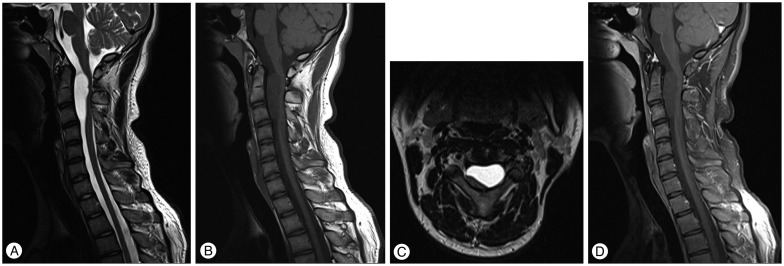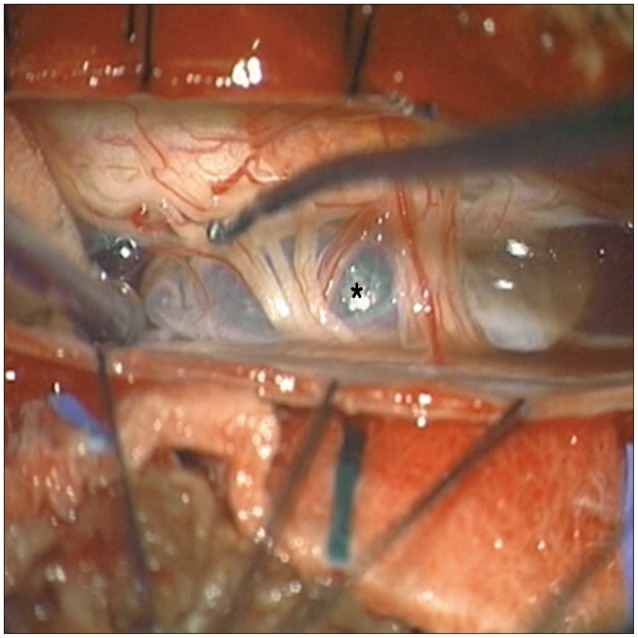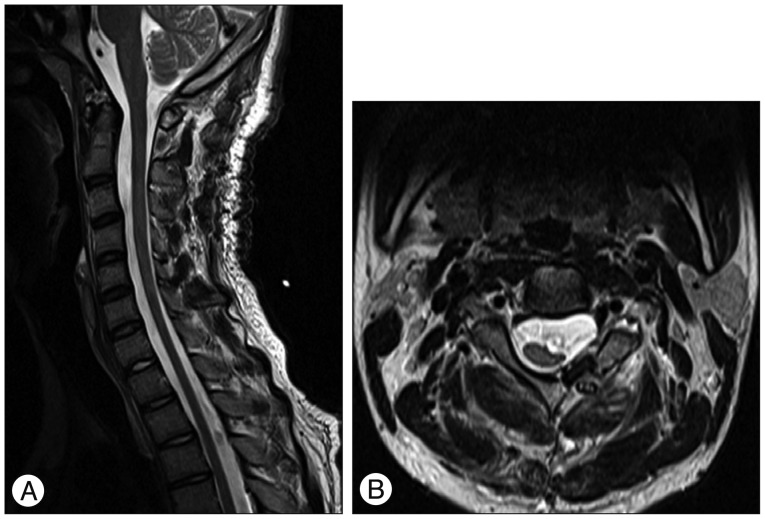1. Agnoli AL, Laun A, Schönmayr R. Enterogenous intraspinal cysts. J Neurosurg. 1984; 61:834–840. PMID:
6491729.

2. Arai Y, Yamauchi Y, Tsuji T, Fukasaku S, Yokota R, Kudo T. Spinal neurenteric cyst. Report of two cases and review of forty-one cases reported in Japan. Spine (Phila Pa 1976). 1992; 17:1421–1424. PMID:
1462222.
3. Baumann CR, Könü D, Glatzel M, Siegel AM. Thoracolumbar intradural extramedullary bronchiogenic cyst. Acta Neurochir (Wien). 2005; 147:317–319. discussion 319. PMID:
15605199.

4. Brooks BS, Duvall ER, el Gammal T, Garcia JH, Gupta KL, Kapila A. Neuroimaging features of neurenteric cysts : analysis of nine cases and review of the literature. AJNR Am J Neuroradiol. 1993; 14:735–746. PMID:
8517367.
5. Cai C, Shen C, Yang W, Zhang Q, Hu X. Intraspinal neurenteric cysts in children. Can J Neurol Sci. 2008; 35:609–615. PMID:
19235445.

6. de Oliveira RS, Cinalli G, Roujeau T, Sainte-Rose C, Pierre-Kahn A, Zerah M. Neurenteric cysts in children : 16 consecutive cases and review of the literature. J Neurosurg. 2005; 103(6 Suppl):512–523. PMID:
16383250.
7. Devkota UP, Lam JM, Ng H, Poon WS. An anterior intradural neurenteric cyst of the cervical spine : complete excision through central corpectomy approach--case report. Neurosurgery. 1994; 35:1150–1153. discussion 1153-1154. PMID:
7885563.
8. Ergün R, Akdemir G, Gezici AR, Kara C, Ergüngör F. Craniocervical neurenteric cyst without associated abnormalities. Pediatr Neurosurg. 2000; 32:95–99. PMID:
10838509.

9. Eynon-Lewis NJ, Kitchen N, Scaravilli F, Brookes GB. Neurenteric cyst of the cerebellopontine angle : case report. Neurosurgery. 1998; 42:655–658. PMID:
9527002.
10. Garg N, Sampath S, Yasha TC, Chandramouli BA, Devi BI, Kovoor JM. Is total excision of spinal neurenteric cysts possible? Br J Neurosurg. 2008; 22:241–251. PMID:
18348021.

11. Harris CP, Dias MS, Brockmeyer DL, Townsend JJ, Willis BK, Apfelbaum RI. Neurenteric cysts of the posterior fossa : recognition, management, and embryogenesis. Neurosurgery. 1991; 29:893–897. discussion 897-898. PMID:
1758603.
12. Jae CB, Kim TS, Park JT, Lim YJ, Leem W, Kim GK. Intradural extramedullary enterogenous cyst in cervical spine : case report. J Korean Neurosurg Soc. 1998; 27:1741–1745.
13. Kim CY, Wang KC, Choe G, Kim HJ, Jung HW, Kim IO, et al. Neurenteric cyst : its various presentations. Childs Nerv Syst. 1999; 15:333–341. PMID:
10461783.
14. Kim HJ, Min KS, Kim YG, Kim DH. Cervical Intramedullary Neurenteric Cyst in an Elderly Patient. J Korean Neurosurg Soc. 2004; 36:249–253.
15. Kimura H, Nagatomi A, Ochi M, Kurisu K. Intracranial neurenteric cyst with recurrence and extensive craniospinal dissemination. Acta Neurochir (Wien). 2006; 148:347–352. discussion 352. PMID:
16421766.

16. Kumar R, Nayak SR. Unusual neuroenteric cysts : diagnosis and management. Pediatr Neurosurg. 2002; 37:321–330. PMID:
12422047.

17. Lippman CR, Arginteanu M, Purohit D, Naidich TP, Camins MB. Intramedullary neurenteric cysts of the spine. Case report and review of the literature. J Neurosurg. 2001; 94(2 Suppl):305–309. PMID:
11302637.
18. Mann KS, Khosla VK, Gulati DR, Malik AK. Spinal neurenteric cyst. Association with vertebral anomalies, diastematomyelia, dorsal fistula, and lipoma. Surg Neurol. 1984; 21:358–362. PMID:
6701769.

19. Menezes AH, Traynelis VC. Spinal neurenteric cysts in the magnetic resonance imaging era. Neurosurgery. 2006; 58:97–105. discussion 97-105. PMID:
16385333.

20. Osborn AG. Diagnostic imaging : Brain. Salt Lake City, UT: Amirsys;2004. p. 7–40.
21. Osborn AG, Preece MT. Intracranial cysts : radiologic-pathologic correlation and imaging approach. Radiology. 2006; 239:650–664. PMID:
16714456.

22. Paleologos TS, Thom M, Thomas DG. Spinal neurenteric cysts without associated malformations. Are they the same as those presenting in spinal dysraphism? Br J Neurosurg. 2000; 14:185–194. PMID:
10912193.

23. Palma L, Di Lorenzo N. Spinal endodermal cysts without associated vertebral or other congenital abnormalities. Report of four cases and review of the literature. Acta Neurochir (Wien). 1976; 33:283–300. PMID:
941718.

24. Puusepp M. Variété rare de tératome sous-dural de al region cervicale (intestinome) : Quadriplégie, extirpation, guérison complète. Rev Neurol. 1934; 2:879–886.
25. Rao MB, Rout D, Misra BK, Radhakrishnan VV. Craniospinal and spinal enterogenous cysts--report of three cases. Clin Neurol Neurosurg. 1996; 98:32–36. PMID:
8681476.
26. Rotondo M, D'Avanzo R, Natale M, Pasqualetto L, Bocchetti A, Agozzino L, et al. Intramedullary neurenteric cysts of the spine. Report of three cases. J Neurosurg Spine. 2005; 2:372–376. PMID:
15796365.
27. Sakata H, Fujimura M, Iwasaki M, Tominaga T. Neurenteric cyst of the craniocervical junction in an infant. Neurol Med Chir (Tokyo). 2008; 48:86–89. PMID:
18296879.
28. Saunders RL de CH. Combined anterior and posterior spina bifida in aliving neonatal human female. Anal Rec. 1943; 87:255–278.
29. Shenoy SN, Raja A. Spinal neurenteric cyst. Report of 4 cases and review of the literature. Pediatr Neurosurg. 2004; 40:284–292. PMID:
15821359.
30. Takase T, Ishikawa M, Nishi S, Aoki T, Wada E, Owaki H, et al. A recurrent intradural cervical neurenteric cyst operated on using an anterior approach : a case report. Surg Neurol. 2003; 59:34–39. discussion 39. PMID:
12633954.

31. Tuzun Y, Izci Y, Sengul G, Erdogan F, Suma S. Neurenteric cyst of the upper cervical spine : excision via posterior approach. Pediatr Neurosurg. 2006; 42:54–56. PMID:
16357503.

32. Wilkens RH, Odom GL. Spinal intradural cysts. In : Vinkin PJ, Bruyn GW, editors. Handbook of Clinical Neurology. Amsterdam: North Holland;1976. Vol 20:p. 55–102.





 PDF
PDF ePub
ePub Citation
Citation Print
Print





 XML Download
XML Download